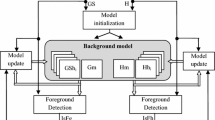Abstract
This paper describes a simple method of fast background subtraction based upon disparity verification that is invariant to arbitrarily rapid run-time changes in illumination. Using two or more cameras, the method requires the off-line construction of disparity fields mapping the primary background images. At runtime, segmentation is performed by checking background image to each of the additional auxiliary color intensity values at corresponding pixels. If more than two cameras are available, more robust segmentation can be achieved and, in particular, the occlusion shadows can be generally eliminated as well. Because the method only assumes fixed background geometry, the technique allows for illumination variation at runtime. Since no disparity search is performed, the algorithm is easily implemented in real-time on conventional hardware.
Similar content being viewed by others
References
Brill, F.Z., Olson, T.J., and Tserng, C. 1998. Event recognition and reliability improvements for the autonomous video surveillance system. In Image Understanding Workshop, Monterey, CA, pp. 267–283.
Darrell, T., Maes, P., Blumberg, B., and Pentland, A. 1994. A novel environment for situated vision and behavior. In Proc. of CVPR-94 Workshop for Visual Behaviors, Seattle, Washington, pp. 68–72.
Friedman, N. and Russell, S. 1997. Image segmentation in video sequences: A probabilistic approach. In Thirteenth Conference on Uncertainty in Artificial Intelligence.
Gaspar, J., Santos-Victor, J., and Sentieiro, J. 1994. Ground plane obstacle detection with a stereo vision system. In International Workshop on Intelligent Robotic Systems.
Intille, S.S., Davis, J.W., and Bobick, A.F. 1997. Real-time closed-world tracking. In Proc. of CVPR-97, San Juan, Puerto Rico, pp. 697–703.
Kanade, T. 1995. A stereo machine for video-rate dense depth mapping and its new applications. In Proc. of Image Understanding Workshop, Palm Springs, California, pp. 805–811.
Okutomi, M. and Kanade, T. 1993. A multiple-baseline stereo. IEEE Trans. on Pattern Analysis and Machine Intelligence, 15(4):353–363.
Oliver, N., Rosario, B., and Pentland, A. 1999. A Bayesian computer vision system for modeling human interactions. In Proceedings of ICVS99, Gran Canaria, Spain.
Pinhanez, C.S. and Bobick, A.F. 1999. 'It/I': A theater play featuring an autonomous computer graphics character. In Proc. of the ACM Multimedia'98 Workshop on Technologies for Interactive Movies, Bristol, England, pp. 22–29.
Stauffer, C. and Grimson, W. 1999. Adaptive background mixture models for real-time tracking. In Proc. of CVPR-99, Ft. Collins, CO, pp. 246–252.
Wren, C., Azarbayejani, A., Darrell, T., and Pentland, A. 1997. Pfinder: Real-time tracking of the human body. IEEE Trans. on Pattern Analysis and Machine Intelligence, 19(7):780–785.
Author information
Authors and Affiliations
Rights and permissions
About this article
Cite this article
Ivanov, Y., Bobick, A. & Liu, J. Fast Lighting Independent Background Subtraction. International Journal of Computer Vision 37, 199–207 (2000). https://doi.org/10.1023/A:1008107805263
Issue Date:
DOI: https://doi.org/10.1023/A:1008107805263




